A View Of The Apollo 11 Lunar Module “Eagle” As It Returned From The Surface Of The Moon To Dock

A view of the Apollo 11 lunar module “Eagle” as it returned from the surface of the Moon to dock with the command module “Columbia”. A smooth mare area is visible on the Moon below and a half-illuminated Earth hangs over the horizon. The lunar module ascent stage was about 4 meters across. Command module pilot Michael Collins took this picture just before docking at 21:34:00 UT (5:34 p.m. EDT) 21 July 1969. (Apollo 11, AS11-44-6642)
Credit: Apollo 11, NASA
More Posts from Venusearthpassage and Others



Venus is the second closest planet to the Sun and has the highest surface temperature of any planet in our solar system, with an orbital period of about 225 Earth days. Because of its similar gravity and size, it is sometimes known as Earth’s “sister planet.” However, besides these two aspects, the two planets have almost nothing in common. With the densest atmosphere on any terrestrial planet in the solar system, the surface pressure on Venus is about 92 times that of Earth; the same pressure one kilometer beneath Earth’s oceans.
Even though Venus is comparatively much further away from the Sun than Mercury, it is the hotter planet with a surface temperature of around 462 °C; this is because of its dense atmosphere of greenhouse gases such as carbon dioxide and sulfur dioxide. One remarkable aspect of the atmosphere of Venus is the precipitation of liquid sulfuric acid. The surface geology of the planet has been observed by NASA for over twenty years now, and it is seen that there is extensive and violent volcanism at the surface.
(image sources: NASA; http://www.the8planets.com/wp-content/gallery/planet-venus/venus-atmosphere.jpg, http://www.boskowan.com/blanensko/)
Meet Our New Flight Directors!
We just hired six new flight directors to join a unique group of individuals who lead human spaceflights from mission control at our Johnson Space Center in Houston.

A flight director manages all human spaceflight missions and related test flights, including International Space Station missions, integration of new American-made commercial spacecraft and developing plans for future Orion missions to the Moon and beyond.
Only 97 people have served as flight directors, or are in training to do so, in the 50-plus years of human spaceflight. That’s fewer than the over 300 astronauts! We talked with the new class about their upcoming transitions, how to keep calm in stressful situations, the importance of human spaceflight and how to best learn from past mistakes. Here’s what they had to say…
Allison Bollinger

Allison is from Lancaster, Ohio and received a BS in Aerospace Engineering from Purdue University. She wanted to work at NASA for as long as she can remember. “I was four-and-a-half when Challenger happened,” she said. “It was my first childhood memory.” Something in her clicked that day. “After, when people asked what I wanted to be when I grew up, I said an astronaut.”
By high school a slight fear of heights, a propensity for motion sickness and an aptitude for engineering shifted her goal a bit. She didn’t want to be an astronaut. “I wanted to train astronauts,” she said. Allison has most recently worked at our Neutral Buoyancy Lab managing the daily operations of the 40-ft-deep pool the astronauts use for spacewalk training! She admits she’ll miss “the smell of chlorine each day. Coming to work at one of the world’s largest pools and training astronauts is an incredible job,” she says. But she’s excited to be back in mission control, where in a previous role she guided astronauts through spacewalks.
She’s had to make some tough calls over the years. So we asked her if she had any tips for when something… isn’t going as planned. She said, “It’s so easy to think the sky is falling. Take a second to take a deep breath, and then you’ll realize it’s not as bad as you thought.”
Adi Boulos

Adi is from Chicago, Illinois and graduated from the University of Illinois Urbana Champaign with a BS in Aerospace Engineering. He joined us in 2008 as a member of the very first group of flight controllers that specialize in data handling and communications and tracking systems aboard the space station.
Most recently he served as the group lead in the Avionics Trainee group, which he loved. “I was managing newer folks just coming to NASA from college and getting to become flight controllers,” he said. “I will miss getting to mentor them from day one.” But he’s excited to start his new role alongside some familiar faces already in mission control. “It’s a great group of people,” he said of his fellow 2018 flight director class. “The six of us, we mesh well together, and we are all from very diverse backgrounds.”
As someone who has spent most of his career supporting human spaceflight and cargo missions from mission control, we asked him why human spaceflight is so important. He had a practical take. “It allows us to solve problems we didn’t know we had,” he said. “For example, when we went to the moon, we had to solve all kinds of problems on how to keep humans alive for long-duration flights in space which directly impacts how we live on the ground. All of the new technology we develop for living in space, we also use on the ground.”
Marcos Flores

Marcos is from Caguas, Puerto Rico and earned a BS in Mechanical Engineering from the University of Puerto Rico and an MS in Aerospace Engineering from Purdue University. Spanish is his first language; English is his second.
The first time he came to the Continental US was on a trip to the Kennedy Space Center in Florida as a kid! “I always knew I wanted to work for NASA,” he said. “And I knew I wanted to be an engineer because I liked to break things to try to figure out how they worked.” He joined us in 2010 as an intern in a robotics laboratory working on conceptual designs for an experimental, autonomous land rover. He later transitioned to the space station flight control team, where he has led various projects, including major software transitions, spacewalks and commercial cargo missions!
He shares his new coworkers’ thoughts on the practical aspects of human spaceflight and believes it’s an expression of our “drive to explore” and our “innate need to know the world and the universe better.” But for him, “It’s more about answering the fundamental questions of where we come from and where we’re headed.”
Pooja Jesrani

Pooja graduated from The University of Texas at Austin with a BS in Aerospace Engineering. She began at NASA in 2007 as a flight controller responsible for the motion control system of the International Space Station. She currently works as a Capsule Communicator, talking with the astronauts on the space station, and on integration with the Boeing Starliner commercial crew spacecraft.
She has a two-year-old daughter, and she’s passionate about motherhood, art, fashion, baking, international travel and, of course, her timing as a new flight director! “Not only have we been doing International Space Station operations continuously, and we will continue to do that, but we are about to launch U.S. crewed vehicles off of U.S. soil for the first time since the space shuttle in 2011. Exploration is ramping up and taking us back to the moon!” she said.” “By the time we get certified, a lot of the things we will get to do will be next-gen.”
We asked her if she had any advice for aspiring flight directors who might want to support such missions down the road. “Work hard every day,” she said. “Every day is an interview. And get a mentor. Or multiple mentors. Having mentorship while you progress through your career is very important, and they really help guide you in the right direction.”
Paul Konyha
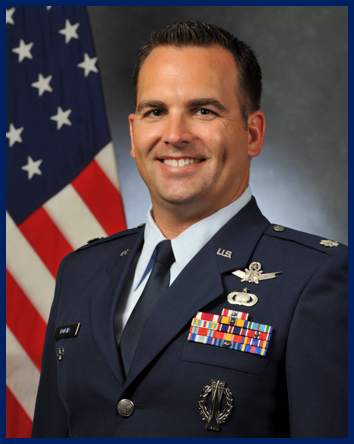
Paul was born in Manhasset, NY, and has a BS in Mechanical Engineering from Louisiana Tech University, a Master’s of Military Operational Arts and Science from Air University, and an MS in Astronautical Engineering from the University of Southern California. He began his career as an officer in the United States Air Force in 1996 and authored the Air Force’s certification guide detailing the process through which new industry launch vehicles (including SpaceX’s Falcon 9) gain approval to launch Department of Defense (DoD) payloads.
As a self-described “Star Wars kid,” he has always loved space and, of course, NASA! After retiring as a Lieutenant Colonel in 2016, Paul joined Johnson Space Center as the Deputy Director of the DoD Space Test Program Human Spaceflight Payloads Office. He’s had a rich career in some pretty high-stakes roles. We asked him for advice on handling stress and recovering from life’s occasional setbacks. “For me, it’s about taking a deep breath, focusing on the data and trying not to what if too much,” he said. “Realize that mistakes are going to happen. Be mentally prepared to know that at some point it’s going to happen—you’re going to have to do that self-reflection to understand what you could’ve done better and how you’ll fix it in the future. That constant process of evaluation and self-reflection will help you get through it.”
Rebecca Wingfield

Rebecca is from Princeton, Kentucky and has a BS in Mechanical Engineering from the University of Kentucky and an MS in Systems Engineering from the University of Houston, Clear Lake. She joined us in 2007 as a flight controller responsible for maintenance, repairs and hardware installations aboard the space station.
Since then, she’s worked as a capsule communicator for the space station and commercial crew programs and on training astronauts. She’s dedicated her career to human spaceflight and has a special appreciation for the program’s long-term benefits. “As our human race advances and we change our planet in lots of different ways, we may eventually need to get off of it,” she said. “There’s no way to do that until we explore a way to do it safely and effectively for mass numbers of people. And to do that, you have to start with one person.” We asked her if there are any misconceptions about flight directors. She responded, “While they are often steely-eyed missile men and women, and they can be rough around the edges, they are also very good mentors and teachers. They’re very much engaged in bringing up the next generation of flight controllers for NASA.”

Congrats to these folks on leading the future of human spaceflight!
You can learn more about each of them HERE.
Make sure to follow us on Tumblr for your regular dose of space: http://nasa.tumblr.com
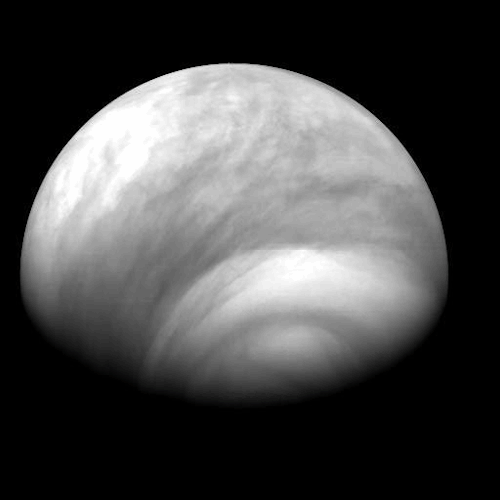
Sequence of Venus atmosphere images taken by the Venus Monitoring Camera (VMC) during the Venus Express orbit in July 2007. The view shows the southern hemisphere of the planet.
Credit: ESA/MPS/DLR/IDA









SpaceTime 20180309 Series 21 Episode 19 is now out
SpaceTime covers the latest news in astronomy & space sciences.
The show is available as a free twice weekly podcast through Apple Podcasts (itunes), Stitcher, Pocketcasts, SoundCloud, Bitez.com, YouTube, Audio Boom, your favourite podcast download provider, and from www.spacetimewithstuartgary.com
SpaceTime is also broadcast coast to coast across the United States on Science360 Radio by the National Science Foundation in Washington D.C. around the world on Tune-In Radio and as inflight entertainment aboard Virgin Australia
SpaceTime daily news blog: http://spacetimewithstuartgary.tumblr.com/ SpaceTime facebook: www.facebook.com/spacetimewithstuartgary SpaceTime Instagram @spacetimewithstuartgary SpaceTime twitter feed @stuartgary
Today’s stories…
The strange dense structure discovered below the South Atlantic Anomaly A strange dense structure has been discovered directly below the South Atlantic Anomaly and just above the Earth’s core mantle boundary. The object may provide important clues about the Earth’s magnetic field and when it’s next likely to reverse polarity.
New gravity mission to monitor climate change NASA’s next Earth Gravity mission is slated to launch aboard a SpaceX Falcon 9 rocket from the Vandenberg Air Force Base in California on April 14. The twin GRACE-FO spacecraft will continue the work of the original GRACE mission, monitoring how climate change caused by man’s use of fossil fuels was affecting the planet.
New exotic state of matter created Scientists have provided proof for a new state of matter comprising an electron orbiting an atomic nucleus at such a great distance – the space between the two can contain other bound atoms. The discovery raises new questions about the definition of an atom.
The Science Report The deadly legacy of asbestos is only now reaching its peak. Police to deploy drone killers at next month’s Commonwealth Games. Australians dying from alcohol-attributable diseases at the rate of one every 90 minutes. Taking selfies really does make your nose look bigger. A skeptic’s guide to water divining.
SpaceTime Background SpaceTime is Australia’s most respected astronomy and space science news program. The show reports on the latest stories and discoveries making news in astronomy, astrophysics, cosmology, planetary science, galactic and stellar evolution, physics, spaceflight, and general science. SpaceTime features interviews with leading Australian scientists about their latest research. The show is broadcast coast to coast across the United States by the National Science Foundation on Science360 Radio, and is available in Australia as a twice weekly podcast which averages around three million downloads annually. It’s hosted through Bitez.com on all major podcast platforms. SpaceTime is also available as inflight entertainment on Virgin Australia Airlines and on Tune in Radio. The SpaceTime program began life in 1995 as ‘StarStuff’ on ABC NewsRadio. Stuart Gary created the show while he was NewsRadio’s Science Editor and evening News anchor. Gary wrote, produced and hosted the program, consistently achieving almost 9 percent of the Australian national radio audience share - according to the Neilsen ratings survey figures for the five major Australian metro markets (Sydney, Melbourne, Brisbane, Adelaide, & Perth). The StarStuff podcast was hosted by ABC Science on line achieving over 1.3 million downloads annually. The program was axed in 2015 following ABC budget cuts. Gary resigned from the ABC, taking the show and audience with him and rebranding it as SpaceTime. The first SpaceTime episode was broadcast on February 8th 2016 and the show has been in production twice weekly ever since.

So NASA won the internet today…
Solar System: Things to Know This Week
Go for Venus! Fifty-five years ago this week, Mariner 2, the first fully successful mission to explore another planet launched from Cape Canaveral in Florida. Here are 10 things to know about Mariner 2.
1. Interplanetary Cruise

On August 27, 1962, Mariner 2 launched on a three and a half month journey to Venus. The little spacecraft flew within 22,000 miles (about 35,000 kilometers) of the planet.
2. Quick Study

Mariner 2’s scan of Venus lasted only 42 minutes. And, like most of our visits to new places, the mission rewrote the books on what we know about Earth’s sister planet.
3. Hot Planet

The spacecraft showed that surface temperature on Venus was hot enough to melt lead: at least 797 degrees Fahrenheit (425 degrees Celsius) on both the day and night sides.
4. Continuous Clouds
The clouds that make Venus shine so bright in Earth’s skies are dozens of miles thick and permanent. It’s always cloudy on Venus, and the thick clouds trap heat - contributing to a runaway “greenhouse effect.”
5. Night Light

Those clouds are why Venus shines so brightly in Earth’s night sky. The clouds reflect and scatter sunlight, making Venus second only to our Moon in celestial brightness.
6. Under Pressure
Venus’ clouds also create crushing pressure. Mariner 2’s scan revealed pressure on the surface of Venus is equal to pressure thousands of feet under Earth’s deepest oceans.
7. Slow Turn
Mariner 2 found Venus rotates very slowly, and in the opposite direction of most planets in our solar system.
8. Space Travel Is Tough
Mariner 2 was a remarkable accomplishment, considering that in 1962 engineers were still in the very early stages of figuring out how operate spacecraft beyond Earth orbit. The first five interplanetary missions launched - by the U.S. and Soviet Union, the only two spacefaring nations at the time - were unsuccessful.
9. Not Ready for Its Close Up
Mariner 2 carried no cameras. The first close-up pictures of Venus came from NASA’s Mariner 10 in 1974.
10. Hot Shot

The first (and still incredibly rare) photo of the surface of Venus was taken by the Soviet Venera 9 lander, which survived for a little more than a minute under the crushing pressure and intense heat on the ground.
Make sure to follow us on Tumblr for your regular dose of space: http://nasa.tumblr.com

Image of the clouds of Venus via the European Space Agency
(source)
Ten interesting facts about Mars
The ancient Sumerians believed that Mars was Nergal, the god of war and plague. During Sumerian times, Nergal was a minor deity of little significance, but, during later times, his main cult center was the city of Nineveh. In Mesopotamian texts, Mars is referred to as the “star of judgement of the fate of the dead”. The existence of Mars as a wandering object in the night sky was recorded by the ancient Egyptian astronomers and, by 1534 BCE, they were familiar with the retrograde motion of the planet. By the period of the Neo-Babylonian Empire, the Babylonian astronomers were making regular records of the positions of the planets and systematic observations of their behavior. For Mars, they knew that the planet made 37 synodic periods, or 42 circuits of the zodiac, every 79 years. They invented arithmetic methods for making minor corrections to the predicted positions of the planets.

Mars is the fourth planet from the Sun and the second-smallest planet in the Solar System after Mercury.

The bright rust color Mars is known for is due to iron-rich minerals in its regolith — the loose dust and rock covering its surface. The soil of Earth is a kind of regolith, albeit one loaded with organic content. According to NASA, the iron minerals oxidize, or rust, causing the soil to look red.

The rotational period and seasonal cycles of Mars are likewise similar to those of Earth, as is the tilt that produces the seasons. Mars is the site of Olympus Mons, the largest volcano and second-highest known mountain in the Solar System, and of Valles Marineris, one of the largest canyons in the Solar System.
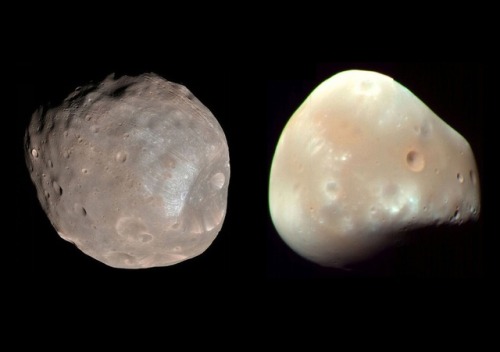
Mars has two moons, Phobos and Deimos, which are small and irregularly shaped. These may be captured asteroids, similar to 5261 Eureka, a Mars trojan.
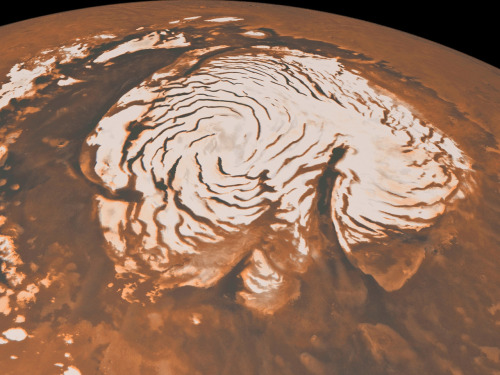
There are ongoing investigations assessing the past habitability potential of Mars, as well as the possibility of extant life. Future astrobiology missions are planned, including the Mars 2020 and ExoMars rovers. Liquid water cannot exist on the surface of Mars due to low atmospheric pressure, which is less than 1% of the Earth’s, except at the lowest elevations for short periods. The two polar ice caps appear to be made largely of water. The volume of water ice in the south polar ice cap, if melted, would be sufficient to cover the entire planetary surface to a depth of 11 meters (36 ft). In November 2016, NASA reported finding a large amount of underground ice in the Utopia Planitia region of Mars. The volume of water detected has been estimated to be equivalent to the volume of water in Lake Superior.
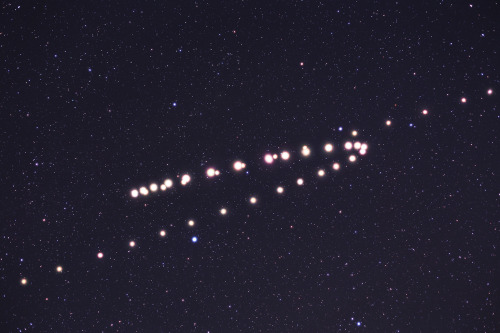
Mars can easily be seen from Earth with the naked eye, as can its reddish coloring. Its apparent magnitude reaches −2.91, which is surpassed only by Jupiter, Venus, the Moon, and the Sun. Optical ground-based telescopes are typically limited to resolving features about 300 kilometers (190 mi) across when Earth and Mars are closest because of Earth’s atmosphere.

Like Earth, Mars has differentiated into a dense metallic core overlaid by less dense materials. Current models of its interior imply a core with a radius of about 1,794 ± 65 kilometers (1,115 ± 40 mi), consisting primarily of iron and nickel with about 16–17% sulfur. This iron(II) sulfide core is thought to be twice as rich in lighter elements as Earth’s. The core is surrounded by a silicate mantle that formed many of the tectonic and volcanic features on the planet, but it appears to be dormant. Besides silicon and oxygen, the most abundant elements in the Martian crust are iron, magnesium, aluminum, calcium, and potassium. The average thickness of the planet’s crust is about 50 km (31 mi), with a maximum thickness of 125 km (78 mi). Earth’s crust averages 40 km (25 mi).

Mars lost its magnetosphere 4 billion years ago, possibly because of numerous asteroid strikes, so the solar wind interacts directly with the Martian ionosphere, lowering the atmospheric density by stripping away atoms from the outer layer. Both Mars Global Surveyor and Mars Expresshave detected ionised atmospheric particles trailing off into space behind Mars, and this atmospheric loss is being studied by the MAVEN orbiter. Compared to Earth, the atmosphere of Mars is quite rarefied.

Mars’s average distance from the Sun is roughly 230 million kilometres (143,000,000 mi), and its orbital period is 687 (Earth) days. The solar day (or sol) on Mars is only slightly longer than an Earth day: 24 hours, 39 minutes, and 35.244 seconds. A Martian year is equal to 1.8809 Earth years, or 1 year, 320 days, and 18.2 hours

Mars is scarred by a number of impact craters: a total of 43,000 craters with a diameter of 5 km (3.1 mi) or greater have been found. The largest confirmed of these is the Hellas impact basin, a light albedo feature clearly visible from Earth. Due to the smaller mass of Mars, the probability of an object colliding with the planet is about half that of Earth. Mars is located closer to the asteroid belt, so it has an increased chance of being struck by materials from that source. Mars is more likely to be struck by short-period comets, i.e., those that lie within the orbit of Jupiter. In spite of this, there are far fewer craters on Mars compared with the Moon, because the atmosphere of Mars provides protection against small meteors and surface modifying processes have erased some craters.
Martian craters can have a morphology that suggests the ground became wet after the meteor impacted.
Source 1
Source 2
images: NASA/JPL-Caltech/Univ. of Arizona , ESA, Tunç Tezel
astronomy facts
Ten Interesting facts about Venus
As one of the brightest objects in the sky, Venus has been a major fixture in human culture for as long as records have existed. It has been made sacred to gods of many cultures, and has been a prime inspiration for writers and poets as the “morning star” and “evening star”. Venus was the first planet to have its motions plotted across the sky, as early as the second millennium BC.
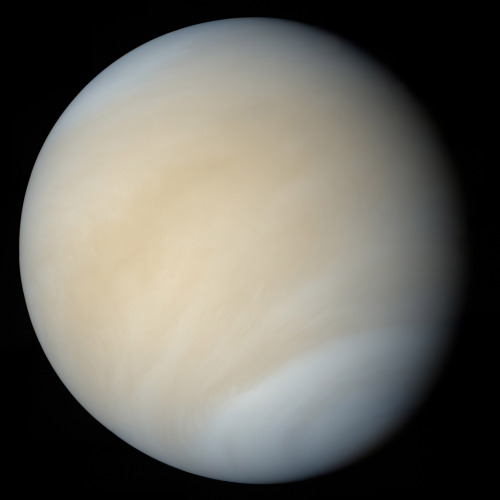
Venus is the second planet from the Sun, orbiting it every 224.7 Earth days. It has the longest rotation period (243 days) of any planet in the Solar System and rotates in the opposite direction to most other planets.

It does not have any natural satellites. It is named after the Roman goddess of love and beauty.
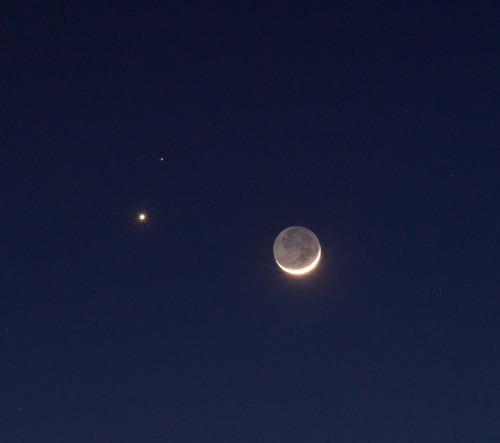
It is the second-brightest natural object in the night sky after the Moon, reaching an apparent magnitude of −4.6 – bright enough to cast shadows at night and, rarely, visible to the naked eye in broad daylight.

Venus is a terrestrial planet and is sometimes called Earth’s “sister planet” because of their similar size, mass, proximity to the Sun, and bulk composition.

It is radically different from Earth in other respects. It has the densest atmosphere of the four terrestrial planets, consisting of more than 96% carbon dioxide. The atmospheric pressure at the planet’s surface is 92 times that of Earth, or roughly the pressure found 900 m (3,000 ft) underwater on Earth. Venus is by far the hottest planet in the Solar System, with a mean surface temperature of 735 K (462 °C; 863 °F), even though Mercury is closer to the Sun.

As the closest planet to Earth, Venus has been a prime target for early interplanetary exploration. It was the first planet beyond Earth visited by a spacecraft (Mariner 2 in 1962), and the first to be successfully landed on (by Venera 7 in 1970). Venus’s thick clouds render observation of its surface impossible in visible light, and the first detailed maps did not emerge until the arrival of the Magellan orbiter in 1991. Plans have been proposed for rovers or more complex missions, but they are hindered by Venus’s hostile surface conditions.

Much of the Venusian surface appears to have been shaped by volcanic activity. Venus has several times as many volcanoes as Earth, and it has 167 large volcanoes that are over 100 km (62 mi) across. The only volcanic complex of this size on Earth is the Big Island of Hawaii. This is not because Venus is more volcanically active than Earth, but because its crust is older. Earth’s oceanic crust is continually recycled by subduction at the boundaries of tectonic plates, and has an average age of about 100 million years, whereas the Venusian surface is estimated to be 300–600 million years old.

As it orbits the Sun, Venus displays phases like those of the Moon in a telescopic view. The planet appears as a small and “full” disc when it is on the opposite side of the Sun (at superior conjunction). Venus shows a larger disc and “quarter phase” at its maximum elongations from the Sun, and appears its brightest in the night sky. The planet presents a much larger thin “crescent” in telescopic views as it passes along the near side between Earth and the Sun. Venus displays its largest size and “new phase” when it is between Earth and the Sun (at inferior conjunction). Its atmosphere is visible through telescopes by the halo of sunlight refracted around it.

The Venusian orbit is slightly inclined relative to Earth’s orbit; thus, when the planet passes between Earth and the Sun, it usually does not cross the face of the Sun. Transits of Venus occur when the planet’s inferior conjunction coincides with its presence in the plane of Earth’s orbit. Transits of Venus occur in cycles of 243 years with the current pattern of transits being pairs of transits separated by eight years, at intervals of about 105.5 years or 121.5 years—a pattern first discovered in 1639 by the English astronomer Jeremiah Horrocks.

In 1967, Venera 4 found Venus’s magnetic field to be much weaker than that of Earth. This magnetic field is induced by an interaction between the ionosphere and the solar wind, rather than by an internal dynamo as in the Earth’s core. Venus’s small induced magnetosphere provides negligible protection to the atmosphere against cosmic radiation.
source
images: Mattias Malmer/NASA/JPL, Peter Barvoets, Soviet Planetary Exploration Program, NSSDC, Marc Lecleire, ESA, C. Carreau,







I do love me a good artist drawing of the Solar System. This time with moons and more facts! Art by Vadim Sadovski.
-
 all11is11one reblogged this · 6 years ago
all11is11one reblogged this · 6 years ago -
 scene-hair-tutorials reblogged this · 7 years ago
scene-hair-tutorials reblogged this · 7 years ago -
 fbis-most-unwanted reblogged this · 7 years ago
fbis-most-unwanted reblogged this · 7 years ago -
 elegant-peach reblogged this · 7 years ago
elegant-peach reblogged this · 7 years ago -
 gaticosycosicas liked this · 7 years ago
gaticosycosicas liked this · 7 years ago -
 blogdelchin reblogged this · 7 years ago
blogdelchin reblogged this · 7 years ago -
 antlrsblg reblogged this · 7 years ago
antlrsblg reblogged this · 7 years ago -
 antlrsblg reblogged this · 7 years ago
antlrsblg reblogged this · 7 years ago -
 antlrsblg reblogged this · 7 years ago
antlrsblg reblogged this · 7 years ago -
 antlrsblg reblogged this · 7 years ago
antlrsblg reblogged this · 7 years ago -
 antlrsblg reblogged this · 7 years ago
antlrsblg reblogged this · 7 years ago -
 antlrsblg reblogged this · 7 years ago
antlrsblg reblogged this · 7 years ago -
 antlrsblg reblogged this · 7 years ago
antlrsblg reblogged this · 7 years ago -
 cyyberteddy reblogged this · 7 years ago
cyyberteddy reblogged this · 7 years ago -
 cyyberteddy liked this · 7 years ago
cyyberteddy liked this · 7 years ago -
 scarlinga liked this · 7 years ago
scarlinga liked this · 7 years ago -
 onekindredspirit liked this · 7 years ago
onekindredspirit liked this · 7 years ago -
 holidayforskins reblogged this · 7 years ago
holidayforskins reblogged this · 7 years ago -
 act8 reblogged this · 7 years ago
act8 reblogged this · 7 years ago -
 ebiroll reblogged this · 7 years ago
ebiroll reblogged this · 7 years ago -
 oldmantheboat reblogged this · 7 years ago
oldmantheboat reblogged this · 7 years ago -
 gabobond reblogged this · 7 years ago
gabobond reblogged this · 7 years ago -
 gabobond liked this · 7 years ago
gabobond liked this · 7 years ago -
 namelyuntitled liked this · 7 years ago
namelyuntitled liked this · 7 years ago -
 chalana liked this · 7 years ago
chalana liked this · 7 years ago -
 birpragmatistinsiradisiolumu reblogged this · 7 years ago
birpragmatistinsiradisiolumu reblogged this · 7 years ago -
 djzabu reblogged this · 7 years ago
djzabu reblogged this · 7 years ago -
 asura-lukas liked this · 7 years ago
asura-lukas liked this · 7 years ago -
 lowhp reblogged this · 7 years ago
lowhp reblogged this · 7 years ago -
 eugeniopari liked this · 7 years ago
eugeniopari liked this · 7 years ago -
 idonotliketheconeofshamesblog reblogged this · 7 years ago
idonotliketheconeofshamesblog reblogged this · 7 years ago -
 megafreshsuit reblogged this · 7 years ago
megafreshsuit reblogged this · 7 years ago -
 stehornby reblogged this · 7 years ago
stehornby reblogged this · 7 years ago -
 marksonbilly liked this · 7 years ago
marksonbilly liked this · 7 years ago -
 dieweltisflach reblogged this · 7 years ago
dieweltisflach reblogged this · 7 years ago -
 dvce liked this · 7 years ago
dvce liked this · 7 years ago -
 zeniansorcerer reblogged this · 7 years ago
zeniansorcerer reblogged this · 7 years ago